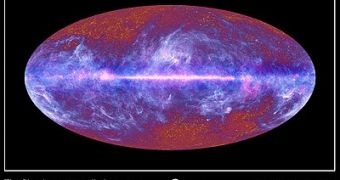This first one-year all-sky survey is a microwave image of the Universe. It gives information about the way galaxies form and also about the way the Universe evolved just after the Big Bang.
In the center of the image is the Milky Way's main disc and clouds of intergalactic dust surround it. This net is where new stars are forming and according to the ESA website, Planck has found many stars that are not born yet, or that are only at the beginning of their life.
At the top and bottom of the image there is maybe the most interesting and intriguing thing. Though not as spectacular as the clouds around the Milky Way, this is a source of valuable information. It is called the ‘cosmic microwave background radiation’ (CMBR) and it is the oldest light in the Universe. The dots we see on the image are the remains of the fireball out of which the Universe was born, 13.7 billion years ago. Their distinct colors are due to small differences in temperature and density.
Thanks to this image we see the Universe as it looks today, but also how it looked short after its time of creation, before any stars or galaxies were born. David Southwood, ESA's Director of Science and Robotic Exploration said: “This is the moment that Planck was conceived for. We’re not giving the answer. We are opening the door to an Eldorado where scientists can seek the nuggets that will lead to deeper understanding of how our Universe came to be and how it works now. The image itself and its remarkable quality is a tribute to the engineers who built and have operated Planck. Now the scientific harvest must begin.”
Planck is a ESA mission with participation from NASA, launched into space from French Guiana in May of 2009. It orbits a distant point about 1.5 million km away, called the second Lagrange point of our Earth-sun system and it continues its mission of scanning the Universe. Before the end of it in 2012, it would have completed four all-sky scans.

 14 DAY TRIAL //
14 DAY TRIAL //